Assessment of Spatial–Temporal Variations of Soil Erosion in Hulunbuir Plateau from 2000 to 2050
Abstract
:1. Introduction
2. Materials and Methods
2.1. Study Area
2.2. Data Sources
2.3. Soil Erosion Model and Factor Calculation
2.3.1. Soil Erosion Model (RUSLE)
2.3.2. Rainfall Erosion Factor (R Factor)
2.3.3. Slope Length Factor (S and L Factor)
2.3.4. Soil Erodibility Factor (K Factor)
2.3.5. Vegetation Cover and Crop Management Factors (C Factor)
2.3.6. Soil and Water Conservation Measures Factor (P Factor)
2.4. Future Projection
2.4.1. Land Patch Prediction Model (PLUS)
2.4.2. P Factor
2.4.3. R Factor
2.4.4. C Factor
2.5. Data Classification and Factor Analysis
2.5.1. Significance of Data Per Issue
2.5.2. Classification of Soil Erosion Grades
2.5.3. Classification of Land Use Type
2.5.4. Classification of Slope Grades
2.5.5. Comparison of Soil Erosion Projections under Three Scenarios
3. Results
3.1. Historical Changes in Soil Erosion
3.1.1. Dynamic Changes in Regional Soil Erosion Distribution Pattern
3.1.2. Soil Erosion of Different Land Use Types
3.1.3. Soil Erosion at Different Slopes
3.2. Soil Erosion Forecast
3.2.1. Soil Erosion from 2025–2050 under the SSP245 Scenario
3.2.2. Comparison of Soil Erosion Projections for 2035 and 2050 under Three Scenarios
4. Discussion
4.1. Major Findings and Results Comparison
4.2. Regional Future Soil Erosion and Recommendations
4.3. Limitations of This Study
5. Conclusions
- (1)
- The average annual soil erosion modules from 2000 to 2020 was 171 t·km−2·yr−1, with the maximum and minimum erosion in the years 2020 and 2005, respectively, with an increase of 42.5%. The maximum erosion modulus was in the eastern part of the study area, followed by the central part. The smallest erosion modulus was in the western region, which coincides with the changes in the tertiary zones. The erosion intensity of the most-eroded area in the tertiary zone was 1.5 times that of the least-eroded area, and the erosion intensity of the most-eroded area in the quaternary zone was about 3.72 times that of the least-eroded area.
- (2)
- Soil erosion in the region occurred mainly in grasslands, with mild and above erosion accounting for a large proportion of cropland erosion and weaker erosion in forest lands. All three main land use types showed aggravating erosion, with the largest change in and proportion of erosion in cropland (moderate and above erosion), indicating that soil erosion here needs special attention. No moderate and above erosion occurred in the regional 0–8° area. Moderate and above soil erosion mainly occurred in the 8–25° area, and strong and above erosion in the 15–35° area accounted for more than moderate erosion in 2020.
- (3)
- The average annual soil erosion modules from 2025 to 2050 was 280 t·km−2·yr−1, which is 64% higher than the historical annual average. The average annual erosion intensities in shrubland high-cover grassland (II13), high-cover grassland (II11), and medium-cover grassland (II12) were 1.87, 1.56, and 1.2 times the historical annual average, respectively. The future spatial erosion change was similar to the historical change, and the erosion intensity of the most-eroded area in the three zones was 3.3 times that of the least-eroded area. Furthermore, the erosion intensity of the most-eroded area in the four zones was ~5.6 times that of the least-eroded area, and the regional erosion gap was expanded compared with the historical period. Soil erosion increased substantially in all three future scenarios, with relatively moderate soil erosion in the SSP245 scenario.
Author Contributions
Funding
Institutional Review Board Statement
Informed Consent Statement
Data Availability Statement
Acknowledgments
Conflicts of Interest
References
- Lal, R. Soil erosion and the global carbon budget. Environ. Int. 2003, 29, 437–450. [Google Scholar] [CrossRef]
- Rickson, R.J. Can control of soil erosion mitigate water pollution by sediments? Sci. Total Environ. 2014, 468, 1187–1197. [Google Scholar] [CrossRef]
- Efthimiou, N.; Lykoudi, E.; Psomiadis, E. Inherent relationship of the USLE, RUSLE topographic factor algorithms and its impact on soil erosion modelling. Hydrol. Sci. J. 2020, 65, 1879–1893. [Google Scholar] [CrossRef]
- Ouyang, Z.; Wang, X.; Miao, H. A preliminary study of terrestrial ecosystem service functions and their ecological and economic values in China. J. Ecol. 1999, 199, 607–613. [Google Scholar]
- Zhao, T.; Ouyang, Z.; Jia, L.; Zheng, H. Ecosystem services and their valuation of China grassland. Acta Ecol. Sin. 2004, 24, 1101–1110. [Google Scholar]
- Zhao, J.; Yang, Z.; Govers, G.J.G. Soil and water conservation measures reduce soil and water losses in China but not down to background levels: Evidence from erosion plot data. Geoderma 2019, 337, 729–741. [Google Scholar] [CrossRef]
- Chen, C.; Zhao, G.; Mu, X.; Tian, P.; Liu, L. Spatial-Temporal Change of Soil Erosion in Huangshui Watershed Based on RUSLE Model. J. Soil Water Conserv. 2021, 35, 73–79. [Google Scholar]
- Kinnell, P. Event soil loss, runoff and the Universal Soil Loss Equation family of models: A review. J. Hydrol. 2010, 385, 384–397. [Google Scholar] [CrossRef]
- Sun, W.; Shao, Q.; Liu, J.; Zhai, J. Assessing the effects of land use and topography on soil erosion on the Loess Plateau in China. Catena 2014, 121, 151–163. [Google Scholar] [CrossRef]
- Zhang, H.; Zhang, R.; Qi, F.; Liu, X.; Niu, Y.; Fan, Z.; Zhang, Q.; Li, J.; Yuan, L.; Song, Y.J.C. The CSLE model based soil erosion prediction: Comparisons of sampling density and extrapolation method at the county level. Catena 2018, 165, 465–472. [Google Scholar] [CrossRef]
- Grimm, V.; Revilla, E.; Berger, U.; Jeltsch, F.; Mooij, W.M.; Railsback, S.F.; Thulke, H.-H.; Weiner, J.; Wiegand, T.; DeAngelis, D.L. Pattern-oriented modeling of agent-based complex systems: Lessons from ecology. Science 2005, 310, 987–991. [Google Scholar] [CrossRef] [PubMed] [Green Version]
- Wang, C.; Li, T.; Guo, X.; Xia, L.; Lu, C.; Wang, C.J.L. Plus-InVEST Study of the Chengdu-Chongqing urban agglomeration’s land-use change and carbon storage. Land 2022, 11, 1617. [Google Scholar] [CrossRef]
- Liang, X.; Guan, Q.; Clarke, K.C.; Liu, S.; Wang, B.; Yao, Y. Understanding the drivers of sustainable land expansion using a patch-generating land use simulation (PLUS) model: A case study in Wuhan, China. Comput. Environ. Urban Syst. 2021, 85, 101569. [Google Scholar] [CrossRef]
- Wan, H.; Gao, S.; Liu, Y.J.R.S. Grassland degradation monitoring and spatio-temporal variation analysis of the Hulun Buir Ecological Function Region. Resour. Sci. 2016, 38, 1443–1451. [Google Scholar]
- Guo, L.; Lai, Q.; Yi, B. Spatiotemporal changes of net primary productivity of river wetland and its driving factors in hulun buir sandy land in 2000–2014. Res. Soil Water Conserv. 2017, 24, 267–272. [Google Scholar]
- Chen, Z.; Liu, J.; Li, L.; Wu, Y.; Feng, G.; Qian, Z.; Sun, G.-Q. Effects of climate change on vegetation patterns in Hulun Buir Grassland. Phys. A Stat. Mech. Appl. 2022, 597, 127275. [Google Scholar] [CrossRef]
- Sun, X.; Liu, X.; Gao, J.; Zhu, Z.; Zheng, W. Classification system of natural resources for integrated management. Resour. Sci. 2020, 42, 1860–1869. [Google Scholar] [CrossRef]
- Liu, X.H.; Liu, X.J.; Cheng, S.B. Construction of a national natural resources comprehensive observation system and key technologies. Resour. Sci. 2020, 42, 1849–1859. [Google Scholar] [CrossRef]
- Liu, X.; Liu, J. Introduction of Natural Resource Elements Integrated Observation Network Project. Geol. China 2022, 49, 678. [Google Scholar]
- Liu, X.; Liu, J. Introduction to the integrated platform for integrated observation of natural resource elements. Geol. China 2022, 49, 1004. [Google Scholar]
- Zhang, H.; Fan, J.; Huang, L.; Tang, Y.; Yue, Y.; Yang, Y.; Liu, X. Theories and technical methods for the comprehensive regionalization of natural resources in China. Resour. Sci. 2020, 42, 1870–1882. [Google Scholar] [CrossRef]
- Zheng, Y.; Zhang, H.; Liu, X.; Liu, X.; Bao, K.; Wang, X. Analysis of natural resources dynamic change characteristics under comprehensive regionalization in Northeast China from 1990 to 2018. Geol. Surv. China 2021, 8, 100–108. [Google Scholar] [CrossRef]
- Fu, Y.; Tan, C.; Liu, X.; Sun, X.; Yuan, Z.; Zheng, Y. Definition, classification, observation and monitoring of natural resources and their application in territorial planning and governance. Geol. China 2022, 49, 1048–1063. [Google Scholar]
- Li, J.; Sun, R.; Xiong, M.; Yang, G. Estimation of soil erosion based on the RUSLE model in China. Acta Ecol. Sin. 2020, 40, 3473–3485. [Google Scholar]
- Zheng, Y.; Li, F.; Liu, X.; Chang, M.; Zhao, H.; Lai, M.; Zhang, Z. Temporal and spatial variation of natural resources and their ecological environment effects in Northeast China in the past 30 years under the background of industrialization. Geol. China 2022, 49, 1361–1373. [Google Scholar]
- Peng, S.; Ding, Y.; Liu, W.; Li, Z. 1 km monthly temperature and precipitation dataset for China from 1901 to 2017. Earth Syst. Sci. Data 2019, 11, 1931–1946. [Google Scholar] [CrossRef] [Green Version]
- Fischer, G.; Nachtergaele, F.; Prieler, S.; Van Velthuizen, H.; Verelst, L.; Wiberg, D.J.I. Global Agro-Ecological Zones Assessment for Agriculture (GAEZ 2008); IIASA; Laxenburg; Austria and FAO: Rome, Italy, 2008; Volume 10. [Google Scholar]
- Liang, X.; Guan, Q.; Clarke, K.C.; Chen, G.; Guo, S.; Yao, Y.J.L. Mixed-cell cellular automata: A new approach for simulating the spatio-temporal dynamics of mixed land use structures. Landsc. Urban Plan. 2021, 205, 103960. [Google Scholar] [CrossRef]
- Xu, X.; Liu, J.; Zhang, S.; Li, R.; Yan, C.; Wu, S. China Many Periods of Land Use Land Cover Remote Sensing Monitoring Data Set (CNLUCC). In Chinese Academy of Sciences, Resources and Environment Science Data Center Data Registration and Publication System; Resource and Environment Data Cloud Platform: Beijing, China, 2018. [Google Scholar] [CrossRef]
- Yang, J.; Dong, J.; Xiao, X.; Dai, J.; Wu, C.; Xia, J.; Zhao, G.; Zhao, M.; Li, Z.; Zhang, Y. Divergent shifts in peak photosynthesis timing of temperate and alpine grasslands in China. Remote Sens. Environ. 2019, 233, 111395. [Google Scholar] [CrossRef]
- Zhang, W.-B.; Xie, Y.; Liu, B.-Y. Rainfall erosivity estimation using daily rainfall amounts. Sci. Geogr. Sin./Dili Kexue 2002, 22, 711–716. [Google Scholar]
- Shi, W.; Huang, M.; Barbour, S.L. Storm-based CSLE that incorporates the estimated runoff for soil loss prediction on the Chinese Loess Plateau. Soil Tillage Res. 2018, 180, 137–147. [Google Scholar] [CrossRef]
- Moore, I.D.; Burch, G. Physical basis of the length-slope factor in the universal soil loss equation. Soil Sci. Soc. Am. J. 1986, 50, 1294–1298. [Google Scholar] [CrossRef]
- Ganasri, B.; Ramesh, H.J.G.F. Assessment of soil erosion by RUSLE model using remote sensing and GIS-A case study of Nethravathi Basin. Geosci. Front. 2016, 7, 953–961. [Google Scholar] [CrossRef] [Green Version]
- Fu, B.; Zhao, W.; Chen, L.; Zhang, Q.; Lü, Y.; Gulinck, H.; Poesen, J. Assessment of soil erosion at large watershed scale using RUSLE and GIS: A case study in the Loess Plateau of China. Land Degrad. Dev. 2005, 16, 73–85. [Google Scholar] [CrossRef]
- Hammad, A.A.; Lundekvam, H.; Børresen, T.J.E.M. Adaptation of RUSLE in the eastern part of the Mediterranean region. Environ. Manag. 2004, 34, 829–841. [Google Scholar] [CrossRef] [PubMed]
- Fu, B.; Liu, Y.; Lü, Y.; He, C.; Zeng, Y.; Wu, B. Assessing the soil erosion control service of ecosystems change in the Loess Plateau of China. Ecol. Complex. 2011, 8, 284–293. [Google Scholar] [CrossRef]
- Hao, C.; Oguchi, T.; Pan, W. Assessment for soil loss by using a scheme of alterative sub-models based on the RUSLE in a Karst Basin of Southwest China. J. Integr. Agric. 2017, 16, 377–388. [Google Scholar]
- Phinzi, K.; Ngetar, N. The assessment of water-borne erosion at catchment level using GIS-based RUSLE and remote sensing: A review. Int. Soil Water Conserv. Res. 2019, 7, 27–46. [Google Scholar] [CrossRef]
- Tian, P.; Zhu, Z.; Yue, Q.; He, Y.; Zhang, Z.; Hao, F.; Guo, W.; Chen, L.; Liu, M. Soil erosion assessment by RUSLE with improved P factor and its validation: Case study on mountainous and hilly areas of Hubei Province, China. Int. Soil Water Conserv. Res. 2021, 9, 433–444. [Google Scholar] [CrossRef]
- Feng, T.; Chen, H.; Polyakov, V.O.; Wang, K.; Zhang, X.; Zhang, W.J.G. Soil erosion rates in two karst peak-cluster depression basins of northwest Guangxi, China: Comparison of the RUSLE model with 137Cs measurements. Geomorphology 2016, 253, 217–224. [Google Scholar] [CrossRef]
- Sang, L.; Zhang, C.; Yang, J.; Zhu, D.; Yun, W. Simulation of land use spatial pattern of towns and villages based on CA–Markov model. Math. Comput. Model. 2011, 54, 938–943. [Google Scholar] [CrossRef]
- Borrelli, P.; Robinson, D.A.; Fleischer, L.R.; Lugato, E.; Ballabio, C.; Alewell, C.; Meusburger, K.; Modugno, S.; Schütt, B.; Ferro, V. An assessment of the global impact of 21st century land use change on soil erosion. Nat. Commun. 2017, 8, 2013. [Google Scholar] [CrossRef] [PubMed] [Green Version]
- Eyring, V.; Bony, S.; Meehl, G.A.; Senior, C.A.; Stevens, B.; Stouffer, R.J.; Taylor, K. Overview of the Coupled Model Intercomparison Project Phase 6 (CMIP6) experimental design and organization. Geosci. Model Dev. 2016, 9, 1937–1958. [Google Scholar] [CrossRef] [Green Version]
- Johnson, M.D.; Hsieh, W.W.; Cannon, A.J.; Davidson, A.; Bédard, F.J.A. Crop yield forecasting on the Canadian Prairies by remotely sensed vegetation indices and machine learning methods. Agric. For. Meteorol. 2016, 218, 74–84. [Google Scholar] [CrossRef]
- Borrelli, P.; Robinson, D.A.; Panagos, P.; Lugato, E.; Yang, J.E.; Alewell, C.; Wuepper, D.; Montanarella, L.; Ballabio, C. Land use and climate change impacts on global soil erosion by water (2015–2070). Proc. Natl. Acad. Sci. USA 2020, 117, 21994–22001. [Google Scholar] [CrossRef] [PubMed]
- Gong, X.; Du, S.; Li, F.; Ding, Y. Study of mesoscale NDVI prediction models in arid and semiarid regions of China under changing environments. Ecol. Indic. 2021, 131, 108198. [Google Scholar] [CrossRef]
- Hateffard, F.; Mohammed, S.; Alsafadi, K.; Enaruvbe, G.O.; Heidari, A.; Abdo, H.G.; Rodrigo-Comino, J. CMIP5 climate projections and RUSLE-based soil erosion assessment in the central part of Iran. Sci. Rep. 2021, 11, 7273. [Google Scholar] [CrossRef] [PubMed]
- Zhu, P.; Liu, X.; Zheng, Y.; Wang, S.; Huang, L. Tradeoffs and synergies of ecosystem services in key ecological function zones in north China. Acta Ecol. Sin. 2020, 40, 8694–8706. [Google Scholar]
- Zhang, G.; Zeng, G.; Yang, X.; Jiang, Z. Future changes in extreme high temperature over China at 1.5 C–5 C global warming based on CMIP6 simulations. Adv. Atmos. Sci. 2021, 38, 253–267. [Google Scholar] [CrossRef]
- Ma, X.; Zhao, C.; Tao, H.; Zhu, J.; Kundzewicz, Z.W. Projections of actual evapotranspiration under the 1.5 C and 2.0 C global warming scenarios in sandy areas in northern China. Sci. Total Environ. 2018, 645, 1496–1508. [Google Scholar] [CrossRef]
- Xin, X.; Wu, T.; Zhang, J.; Yao, J.; Fang, Y. Comparison of CMIP6 and CMIP5 simulations of precipitation in China and the East Asian summer monsoon. Int. J. Clim. 2020, 40, 6423–6440. [Google Scholar] [CrossRef] [Green Version]
- Tian, J.; Zhang, Z.; Ahmed, Z.; Zhang, L.; Su, B.; Tao, H.; Jiang, T. Projections of precipitation over China based on CMIP6 models. Stoch. Environ. Res. Risk Assess. 2021, 35, 831–848. [Google Scholar] [CrossRef]
- Alewell, C.; Borrelli, P.; Meusburger, K.; Panagos, P. Using the USLE: Chances, challenges and limitations of soil erosion modelling. Int. Soil Water Conserv. Res. 2019, 7, 203–225. [Google Scholar] [CrossRef]
- Wang, X.; Wu, J.; Liu, Y.; Hai, X.; Shanguan, Z.; Deng, L. Driving factors of ecosystem services and their spatiotemporal change assessment based on land use types in the Loess Plateau. J. Environ. Manag. 2022, 311, 114835. [Google Scholar] [CrossRef]
- Wang, B.; Zhao, X.; Wang, X.; Zhang, Z.; Yi, L.; Hu, S. Spatial and temporal variability of soil erosion in the black soil region of Northeast China from 2000 to 2015. Environ. Monit. Assess. 2020, 192, 370. [Google Scholar] [CrossRef]
- Wang, S.; Xu, X.; Huang, L. Spatial and Temporal Variability of Soil Erosion in Northeast China from 2000 to 2020. Remote Sens. 2023, 15, 225. [Google Scholar] [CrossRef]
- Jiang, W.; Pang, Z.; Lv, J.; Ju, H.; Li, L.; Fu, J. Satellite observations reveal decreasing soil erosion in Northeast Inner Mongolia, China, over the past four decades. Front. Earth Sci. 2022, 10. [Google Scholar] [CrossRef]
- Zhu, Y.; Li, W.; Wang, D.; Wu, Z.; Shang, P. Spatial Pattern of Soil Erosion in Relation to Land Use Change in a Rolling Hilly Region of Northeast China. Land 2022, 11, 1253. [Google Scholar] [CrossRef]
- Wang, R.; Zhang, S.; Yang, J.; Pu, L.; Yang, C.; Yu, L.; Chang, L.; Bu, K.J.S. Integrated use of GCM, RS, and GIS for the assessment of hillslope and gully erosion in the Mushi River Sub-Catchment, Northeast China. Sustainability 2016, 8, 317. [Google Scholar] [CrossRef]
- Wang, Z.; Li, X.; Mao, Y.; Li, L.; Wang, X.; Lin, Q. Dynamic simulation of land use change and assessment of carbon storage based on climate change scenarios at the city level: A case study of Bortala, China. Ecol. Indic. 2022, 134, 108499. [Google Scholar] [CrossRef]
- Li, L.; Zhang, D.; Xin, X.; Yan, Y.; Yang, G.; Li, J.; Wang, X. Photosynthetic characteristics of Leymus chinensis under different soil moisture grades in Hulunber prairie. Acta Ecol. Sin. 2009, 29, 5271–5279. [Google Scholar]
- Wendu, R.; Li, G.; Zhang, J.; Lai, X.; Yi, J.; Fan, G.; Yang, D. The study of soil microbial biomass and soil enzyme activity on different grassland in Hulunbeier, Inner Mongolia. Acta Prataculturae Sin. 2010, 19, 94–102. [Google Scholar]
- Yi, K.; Wang, S.; Wang, X. The characteristics of spatial-temporal differentiation of soil erosion based on RUSLE model: A case study of Chaoyang City, Liaoning Province. Sci. Geogr. Sin. 2015, 35, 365–372. [Google Scholar]
- Li, M.; Liang, D.; Xia, J.; Song, J.; Cheng, D.; Wu, J.; Cao, Y.; Sun, H.; Li, Q. Evaluation of water conservation function of Danjiang River Basin in Qinling Mountains, China based on InVEST model. J. Environ. Manag. 2021, 286, 112212. [Google Scholar] [CrossRef] [PubMed]
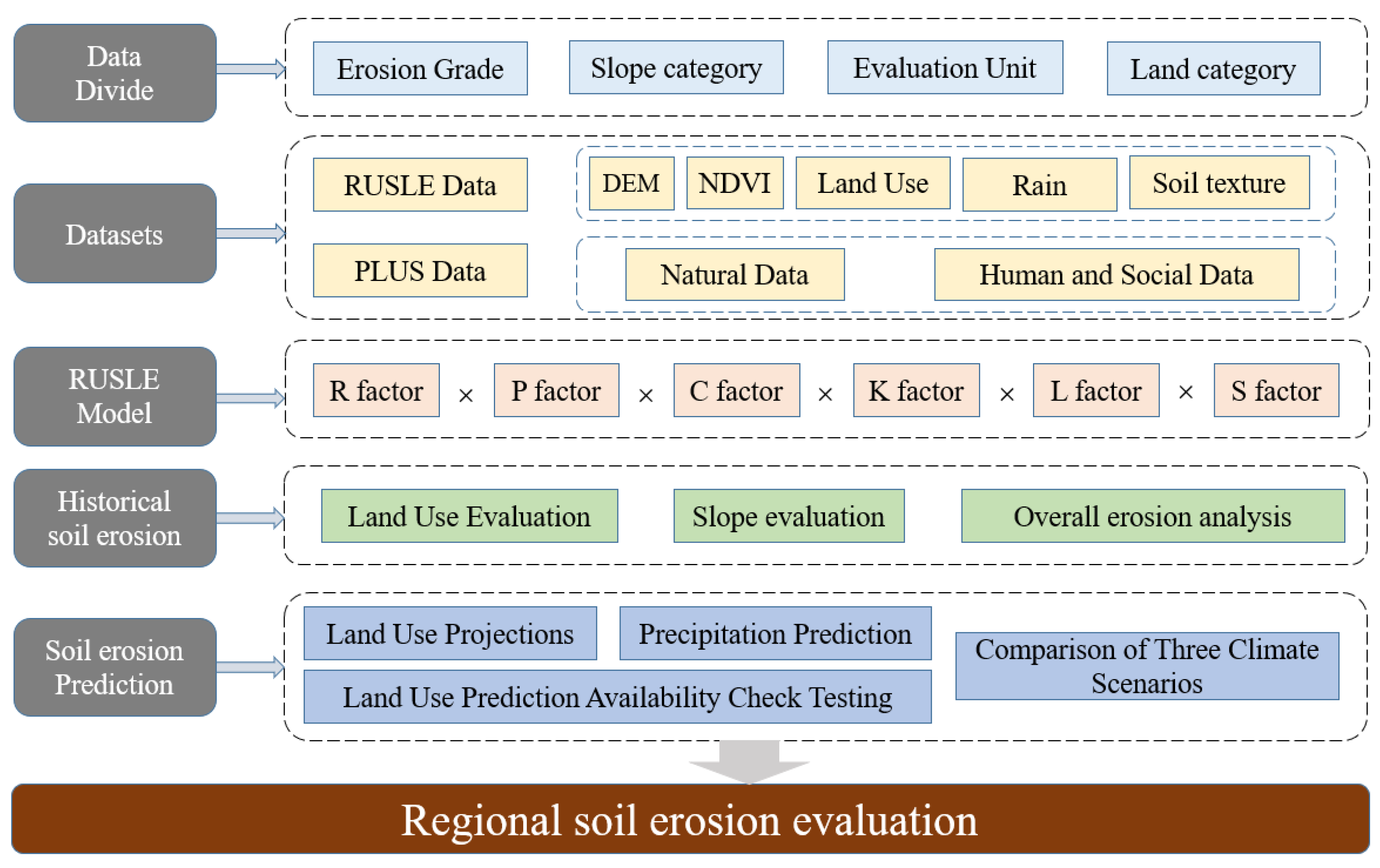

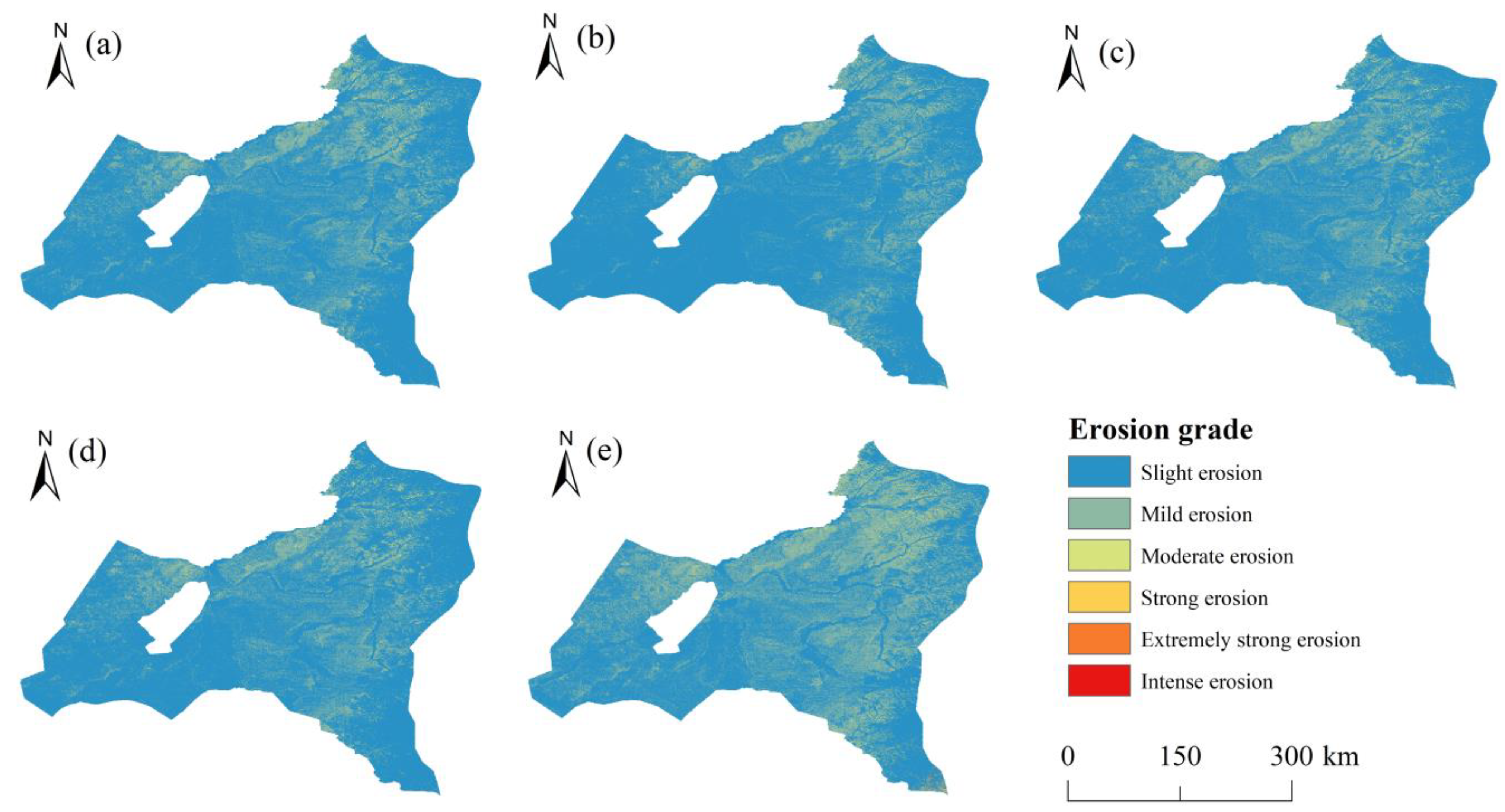


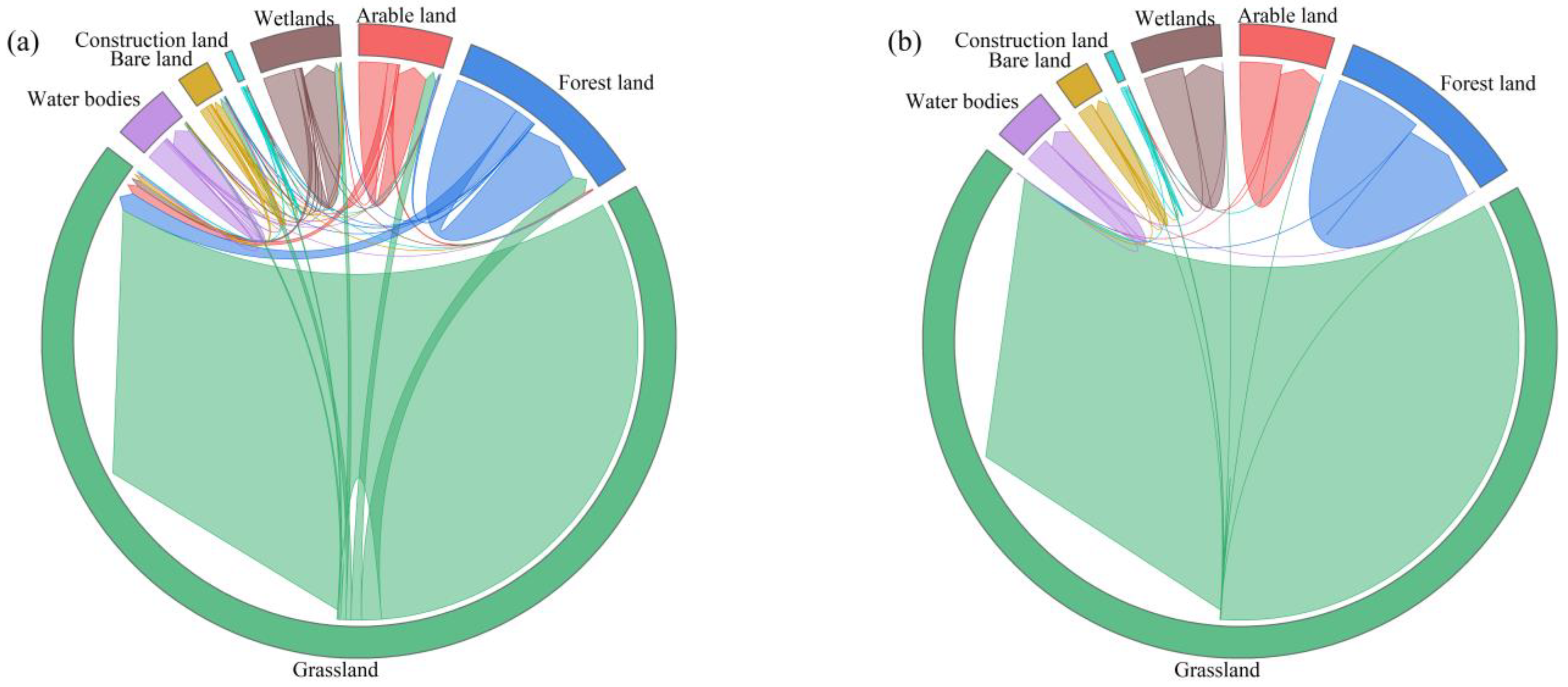
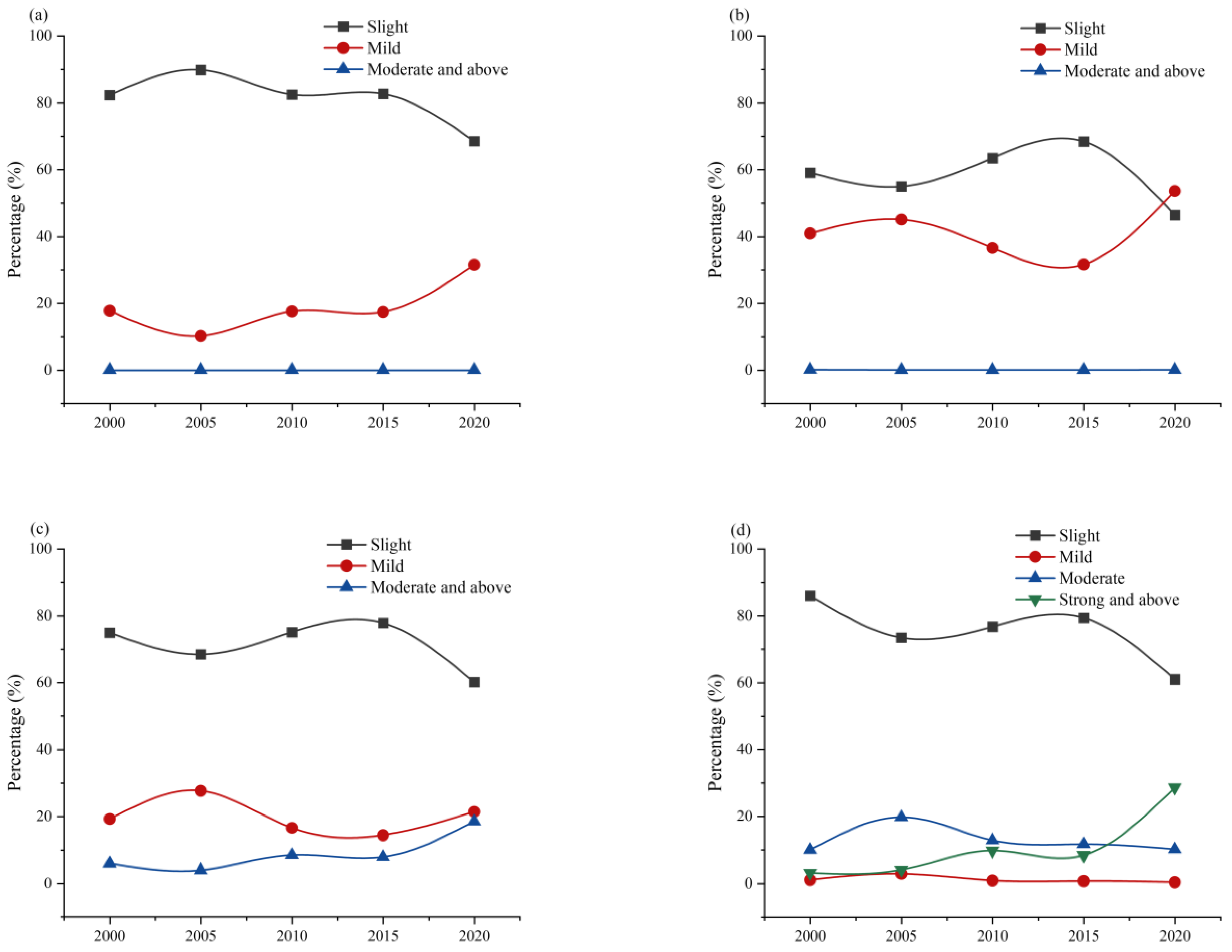

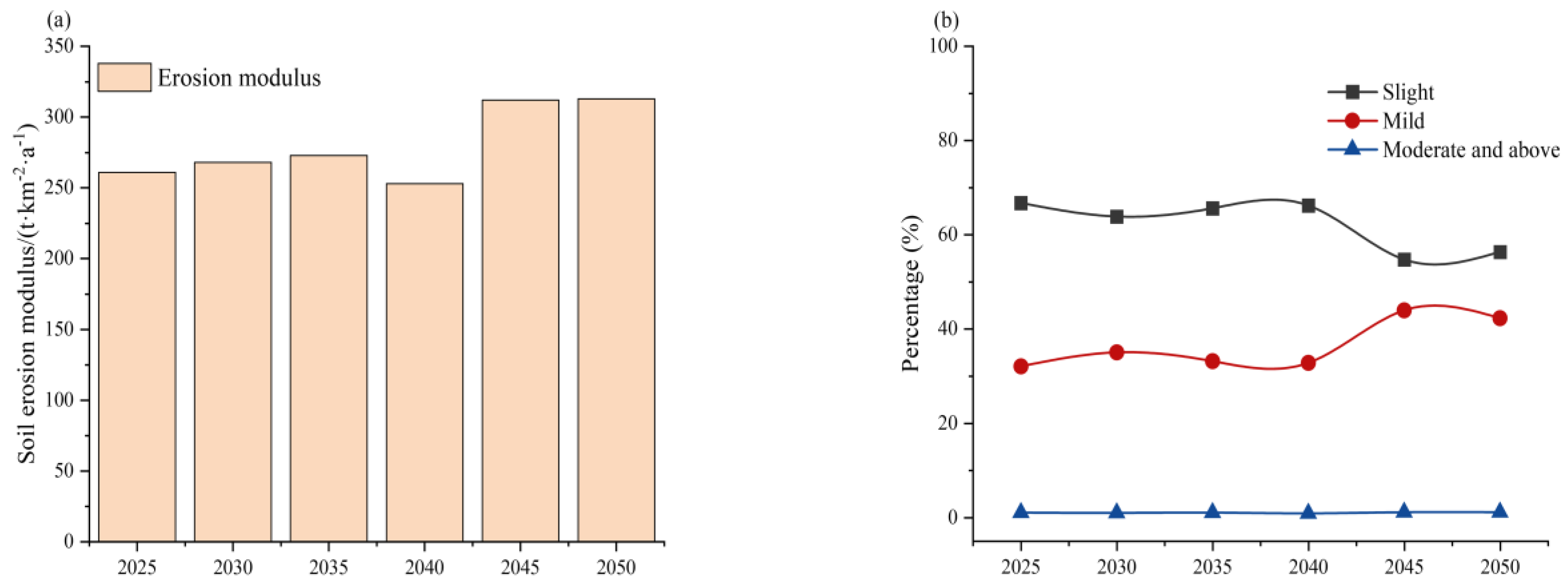


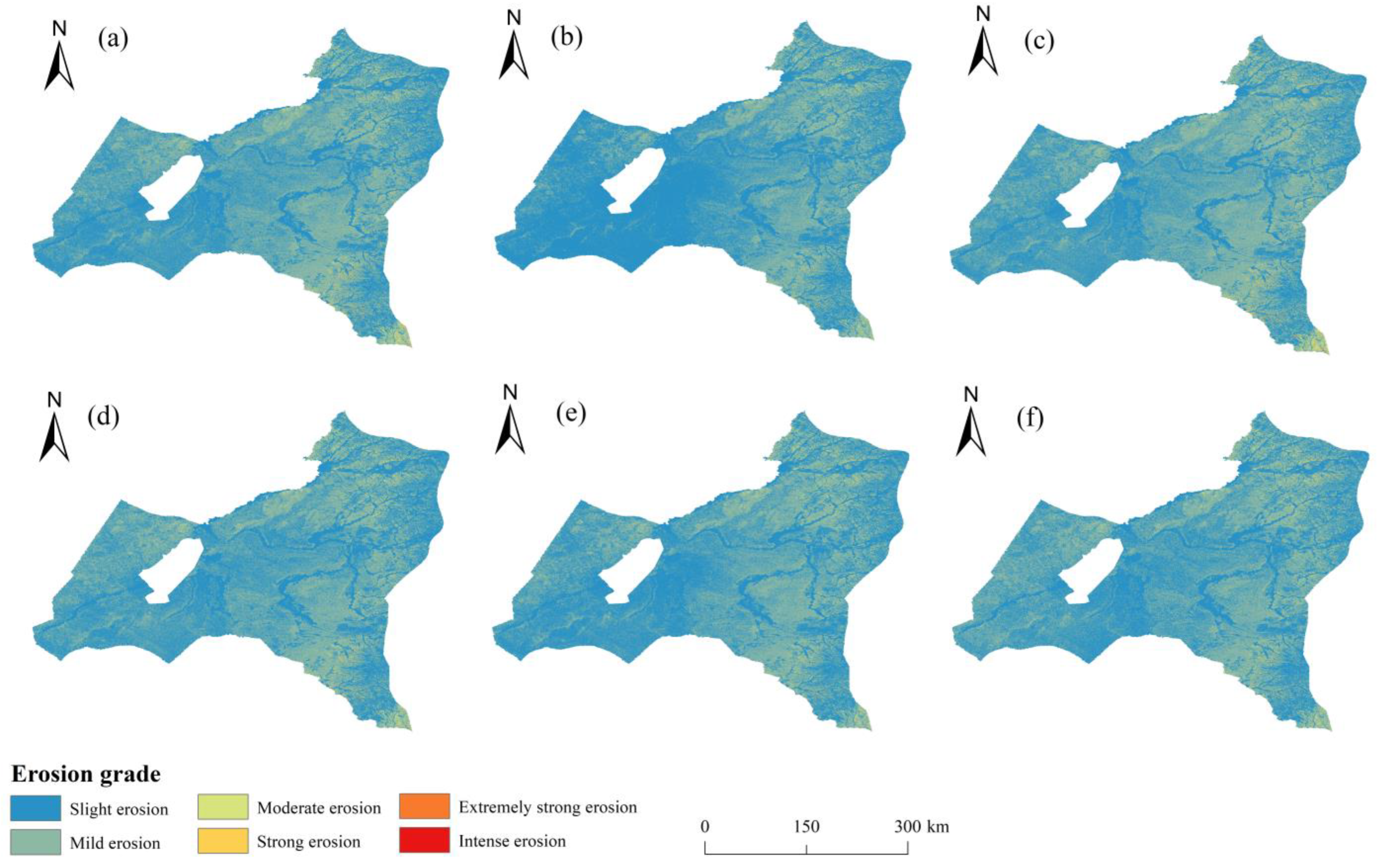

| Data | Sources | |
|---|---|---|
| Rain | Historical | The “1 km monthly temperature and precipitation dataset for China from 1901 to 2017.” published by the National Geoscience Data Center (http://www.geodata.cn/ (accessed on 20 October 2022)) [26] |
| Future | CMIP6 website (https://esgf-node.llnl.gov/projects/cmip6/ (accessed on 20 November 2022)) | |
| DEM | The “ASTER GDEM 30M Resolution Digital Elevation Model” published by the Geospatial Data Cloud Platform of the Computer Network Information Center of the Chinese Academy of Sciences | |
| Soil property data | The HWSD World Soil Database published by the Food and Agriculture Organization of the United Nations (https://www.fao.org/home/ (accessed on 20 October 2022)) [27] | |
| LUCC | The remote sensing monitoring data of land use in China released by the Resource Environment Science and Data Center (https://www.resdc.cn/ (accessed on 20 October 2022)) [28,29] | |
| PLUS | The data are all official releases of open source data that do not need to be cited. The National Geographic Information Resource Service Catalog (https://www.webmap.cn/ (accessed on 20 November 2022)) The China Meteorological Data Network (http://data.cma.cn/ (accessed on 20 November 2022)) The National Geoscience Data Center (http://www.geodata.cn/ (accessed on 20 November 2022)) | |
| NDVI | The “2000–2020 China 30 m annual maximum Normalized Difference Vegetation Index (NDVI) dataset” published by the National Science and Technology Resources Sharing Service Platform [30] (http://www.nesdc.org.cn/ (accessed on 20 October 2022)) | |
| Erosion Grade | Modulus /(t·km−2·yr−1) | Proportion/% | ||||
|---|---|---|---|---|---|---|
| 2000 | 2005 | 2010 | 2015 | 2020 | ||
| Slight | <200 | 79.75 | 85.05 | 80.18 | 81.01 | 59.30 |
| Mild | 200–2500 | 19.68 | 14.38 | 18.95 | 18.20 | 37.26 |
| Moderate | 2500–5000 | 0.53 | 0.52 | 0.72 | 0.67 | 2.26 |
| Strong | 5000–8000 | 0.04 | 0.05 | 0.13 | 0.11 | 0.88 |
| Extremely strong | 8000–15,000 | 0.00 | 0.00 | 0.02 | 0.01 | 0.29 |
| Intense | >15,000 | 0.00 | 0.00 | 0.00 | 0.00 | 0.01 |
| Four-Level Zones | Modulus/(t·km−2·yr−1) | ||||
|---|---|---|---|---|---|
| 2000 | 2005 | 2010 | 2015 | 2020 | |
| II 11-1 | 153 | 127 | 163 | 155 | 210 |
| II 11-2 | 300 | 299 | 300 | 265 | 621 |
| II 11-3 | 112 | 119 | 97 | 78 | 311 |
| II 11-4 | 272 | 242 | 257 | 243 | 452 |
| II 11-5 | 172 | 213 | 211 | 177 | 317 |
| II 11-6 | 109 | 78 | 108 | 109 | 137 |
| II 11-7 | 234 | 188 | 237 | 238 | 330 |
| II 11-8 | 130 | 100 | 136 | 143 | 178 |
| II 11-9 | 101 | 65 | 92 | 94 | 129 |
| II 12-2 | 149 | 102 | 147 | 155 | 201 |
| II 13-1 | 37 | 120 | 114 | 85 | 476 |
| II 13-2 | 127 | 178 | 196 | 143 | 388 |
| Land Use | Erosion Grade | Modulus/ (t·km−2·yr−1) | Proportion/% | ||||
|---|---|---|---|---|---|---|---|
| 2000 | 2005 | 2010 | 2015 | 2020 | |||
| Grassland | Slight | <200 | 76.82 | 83.73 | 77.05 | 77.30 | 61.68 |
| Mild | 200–2500 | 22.55 | 15.72 | 22.03 | 21.87 | 36.61 | |
| Moderate | 2500–5000 | 0.59 | 0.51 | 0.79 | 0.72 | 1.30 | |
| Strong | 5000–8000 | 0.04 | 0.04 | 0.12 | 0.10 | 0.35 | |
| Extremely strong | 8000–15,000 | 0.00 | 0.00 | 0.01 | 0.01 | 0.06 | |
| Intense | >15,000 | 0.00 | 0.00 | 0.00 | 0.00 | 0.00 | |
| Woodland | Slight | <200 | 91.27 | 88.30 | 90.71 | 93.17 | 81.15 |
| Mild | 200–2500 | 7.95 | 10.22 | 7.86 | 5.39 | 15.15 | |
| Moderate | 2500–5000 | 0.66 | 1.26 | 1.01 | 1.05 | 2.03 | |
| Strong | 5000–8000 | 0.10 | 0.19 | 0.35 | 0.34 | 1.12 | |
| Extremely strong | 8000–15,000 | 0.02 | 0.03 | 0.08 | 0.05 | 0.53 | |
| Intense | >15,000 | 0.00 | 0.00 | 0.00 | 0.00 | 0.03 | |
| Arable land | Slight | <200 | 77.50 | 79.25 | 83.71 | 90.96 | 59.29 |
| Mild | 200–2500 | 22.37 | 20.69 | 16.09 | 8.85 | 40.06 | |
| Moderate | 2500–5000 | 0.12 | 0.06 | 0.20 | 0.19 | 0.64 | |
| Strong | 5000–8000 | 0.00 | 0.00 | 0.00 | 0.00 | 0.02 | |
| Extremely strong | 8000–15,000 | 0.00 | 0.00 | 0.00 | 0.00 | 0.00 | |
| Intense | >15,000 | 0.00 | 0.00 | 0.00 | 0.00 | 0.00 | |
| Land Use | Modulus/(t·km−2·yr−1) | ||||
|---|---|---|---|---|---|
| 2000 | 2005 | 2010 | 2015 | 2020 | |
| Grassland | 182 | 156 | 191 | 182 | 301 |
| Arable land | 146 | 138 | 113 | 75 | 264 |
| Woodland | 101 | 133 | 120 | 102 | 338 |
| Construction | 239 | 186 | 247 | 226 | 346 |
| Bare ground | 154 | 113 | 157 | 147 | 221 |
| Wetlands | 0.6 | 0.6 | 0.7 | 0.6 | 1 |
| Four-Level Zones | Modulus/(t·km−2·yr−1) | |||||
|---|---|---|---|---|---|---|
| 2025 | 2030 | 2035 | 2040 | 2045 | 2050 | |
| II 11-1 | 224 | 256 | 252 | 231 | 290 | 292 |
| II 11-2 | 338 | 350 | 427 | 357 | 460 | 495 |
| II 11-3 | 196 | 204 | 274 | 211 | 266 | 297 |
| II 11-4 | 282 | 316 | 406 | 318 | 395 | 438 |
| II 11-5 | 279 | 313 | 346 | 288 | 357 | 371 |
| II 11-6 | 152 | 166 | 139 | 149 | 185 | 180 |
| II 11-7 | 240 | 246 | 285 | 247 | 328 | 330 |
| II 11-8 | 138 | 153 | 153 | 141 | 196 | 190 |
| II 11-9 | 124 | 146 | 101 | 136 | 160 | 153 |
| II 12-2 | 184 | 178 | 153 | 176 | 257 | 215 |
| II 13-1 | 923 | 822 | 697 | 718 | 720 | 722 |
| II 13-2 | 604 | 576 | 534 | 523 | 551 | 566 |
Disclaimer/Publisher’s Note: The statements, opinions and data contained in all publications are solely those of the individual author(s) and contributor(s) and not of MDPI and/or the editor(s). MDPI and/or the editor(s) disclaim responsibility for any injury to people or property resulting from any ideas, methods, instructions or products referred to in the content. |
© 2023 by the authors. Licensee MDPI, Basel, Switzerland. This article is an open access article distributed under the terms and conditions of the Creative Commons Attribution (CC BY) license (https://creativecommons.org/licenses/by/4.0/).
Share and Cite
Yuan, J.; Liu, X.; Li, H.; Wang, R.; Luo, X.; Xing, L.; Wang, C.; Zhao, H. Assessment of Spatial–Temporal Variations of Soil Erosion in Hulunbuir Plateau from 2000 to 2050. Land 2023, 12, 1214. https://doi.org/10.3390/land12061214
Yuan J, Liu X, Li H, Wang R, Luo X, Xing L, Wang C, Zhao H. Assessment of Spatial–Temporal Variations of Soil Erosion in Hulunbuir Plateau from 2000 to 2050. Land. 2023; 12(6):1214. https://doi.org/10.3390/land12061214
Chicago/Turabian StyleYuan, Jianglong, Xiaohuang Liu, Hongyu Li, Ran Wang, Xinping Luo, Liyuan Xing, Chao Wang, and Honghui Zhao. 2023. "Assessment of Spatial–Temporal Variations of Soil Erosion in Hulunbuir Plateau from 2000 to 2050" Land 12, no. 6: 1214. https://doi.org/10.3390/land12061214





